
Ents of Fangorn is a supplement published by Iron Crown Enterprises in 1987 for Middle-earth Role Playing (MERP), a fantasy role-playing game based on J.R.R. Tolkien's The Lord of the Rings .

Ents of Fangorn is a supplement published by Iron Crown Enterprises in 1987 for Middle-earth Role Playing (MERP), a fantasy role-playing game based on J.R.R. Tolkien's The Lord of the Rings .
In The Lord of the Rings, Ents are tree-like creatures who inhabit the forest of Fangorn, which lies between the citadel of Orthanc and the kingdom of Rohan. In Tolkien's masterwork, ents are instrumental in bringing about the downfall of the evil wizard Saruman.
Ents of Fangorn provides details of
The book also includes six ideas for adventures set in the area, although all of them are set outside Fangorn.
ICE published the licensed game Middle Earth Role-Playing in 1982, and then released many supplements for it over the next 17 years, until the Tolkien Estate withdrew their license in 1999. Ents of Fangorn is a 48-page book designed by Randall Doty, with interior art by Liz Danforth and cover art by Angus McBride that includes two center-bound color maps. [1]
In the August 1989 edition of Dragon (Issue #148), Jim Bambra thought that "Ents of Fangorn is a good example of how to portray monsters in an interesting style, while still staying true to the splendor and learned feel of Middle-earth." Bambra lauded the fact that in addition to material gleaned from Lord of the Rings, "further insights into ent life and culture are extrapolated from the available background. The supplement makes for interesting reading and portrays the ents as a deeply motivated race with an ancient history." But Bambra was less than impressed by the sample adventures, which largely involved exploring nearby orc lairs. "The dungeon descriptions are reminiscent of the early days of adventure design, when suitably tooled-up parties would raid the lairs of local monsters." Even for two sample adventures that involved ents, Bambra felt that they were "very skimpily outlined, giving no feel for how to handle encounters between PCs and ents. In fact, all of the adventure outlines are short on character interaction and role-playing." Bambra also felt that the setting, while beautifully described, was not used in the adventures at all, "a pity, as Fangorn Forest is a rich setting that, in the hands of a skilled adventure writer, would provide some memorable gaming sessions." He concluded, "As a book on ents, Ents of Fangorn has many uses outside of its MERP setting, but it would have benefited from more development, particularly in showing how this product could be used to stage and run adventures." [2]
Treebeard, or Fangorn in Sindarin, is a tree-giant character in J. R. R. Tolkien's The Lord of the Rings. He is an Ent and is said by Gandalf to be "the oldest living thing that still walks beneath the Sun upon this Middle-earth." He lives in the ancient Forest of Fangorn, to which he has given his name. It lies at the southern end of the Misty Mountains. He is described as being about 14 feet in height, and in appearance similar to a beech or an oak.

The Two Towers is the second volume of J. R. R. Tolkien's high fantasy novel The Lord of the Rings. It is preceded by The Fellowship of the Ring and followed by The Return of the King. The volume's title is ambiguous, as five towers are named in the narrative, and Tolkien himself gave conflicting identifications of the two towers. The narrative is interlaced, allowing Tolkien to build in suspense and surprise. The volume was largely welcomed by critics, who found it exciting and compelling, combining epic narrative with heroic romance.
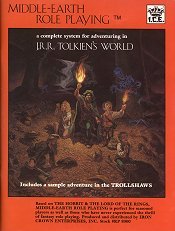
Middle-earth Role Playing (MERP) is a 1984 tabletop role-playing game based on J. R. R. Tolkien'sThe Lord of the Rings and The Hobbit under license from Tolkien Enterprises. Iron Crown Enterprises (I.C.E.) published the game until they lost the license on 22 September 1999.

Iron Crown Enterprises (ICE) is a publishing company that has produced role playing, board, miniature, and collectible card games since 1980. Many of ICE's better-known products were related to J. R. R. Tolkien's world of Middle-earth, but the Rolemaster rules system, and its science-fiction equivalent, Space Master, have been the foundation of ICE's business.
The following outline is provided as an overview of and topical guide to the real-world history and notable fictional elements of J. R. R. Tolkien's fantasy universe. It covers materials created by Tolkien; the works on his unpublished manuscripts, by his son Christopher Tolkien; and films, games and other media created by other people.
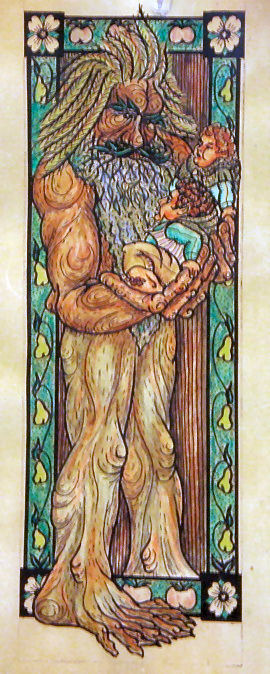
Ents are a species of beings in J. R. R. Tolkien's fantasy world Middle-earth who closely resemble trees; their leader is Treebeard of Fangorn forest. Their name is derived from an Old English word for "giant".

GURPS Fantasy is a Genre Toolkit source book which was first designed by Steve Jackson and published by Steve Jackson Games in 1986 for the GURPS role-playing game. It presented a magic system for the game as well as background information for the fantasy campaign world of Yrth. A second edition by new writers was published in 1990 as GURPS Fantasy: The Magical World of Yrth. These two editions received mixed reviews in game periodicals including Dragon, Space Gamer/Fantasy Gamer, and Games International. The fourth edition of GURPS separates the fantasy parts into fantasy and a setting book called GURPS Banestorm.
The fictional races and peoples that appear in J. R. R. Tolkien's fantasy world of Middle-earth include the seven listed in Appendix F of The Lord of the Rings: Elves, Men, Dwarves, Hobbits, Ents, Orcs and Trolls, as well as spirits such as the Valar and Maiar. Other beings of Middle-earth are of unclear nature such as Tom Bombadil and his wife Goldberry.

In the Dungeons & Dragons role-playing game, orcs are a primitive race of savage, bestial, barbaric humanoid.
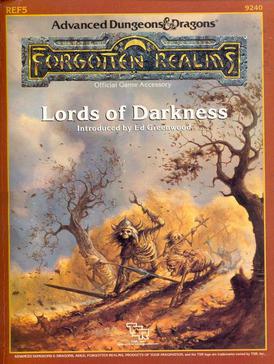
Lords of Darkness is the name of two accessories for the fictional Forgotten Realms campaign setting for the Dungeons & Dragons fantasy role-playing game.
Mirkwood is a name used for a great dark fictional forest in novels by Sir Walter Scott and William Morris in the 19th century, and by J. R. R. Tolkien in the 20th century. The critic Tom Shippey explains that the name evoked the excitement of the wildness of Europe's ancient North.

Middle-earth is the setting of much of the English writer J. R. R. Tolkien's fantasy. The term is equivalent to the Miðgarðr of Norse mythology and Middangeard in Old English works, including Beowulf. Middle-earth is the human-inhabited world, that is, the central continent of the Earth, in Tolkien's imagined mythological past. Tolkien's most widely read works, The Hobbit and The Lord of the Rings, are set entirely in Middle-earth. "Middle-earth" has also become a short-hand term for Tolkien's legendarium, his large body of fantasy writings, and for the entirety of his fictional world.
An orc, in J. R. R. Tolkien's Middle Earth fantasy fiction, is a race of humanoid monsters, which he also calls "goblin".
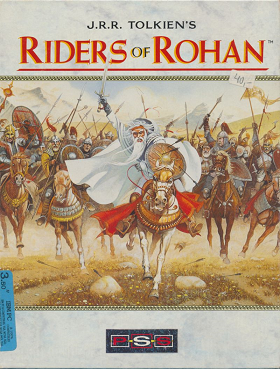
J. R. R. Tolkien's Riders of Rohan is a computer video game from 1991 based upon the fictional War of the Ring set in the Middle-earth world created by J. R. R. Tolkien, centered in The Lord of the Rings novels. The massive-scale simulation takes part in the realm of Rohan and the player controls the forces of Good during the onslaught of the forces of Evil, namely centered on the conflict with Saruman of Isengard. It was published by Konami and Mirrorsoft.

The Orcs of Thar is an accessory for the Dungeons & Dragons fantasy role-playing game, written by Bruce Heard and published by TSR in 1988.
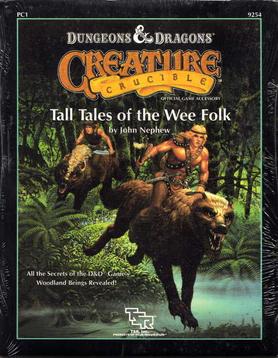
Tall Tales of the Wee Folk is an accessory for the Dungeons & Dragons fantasy role-playing game.
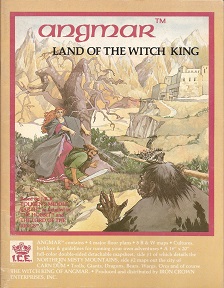
Angmar: Land of the Witch King is a fantasy role-playing sourcebook published by Iron Crown Enterprises (I.C.E.) in 1982 based on J.R.R. Tolkien's The Lord of the Rings trilogy. The book expands upon Tolkien's few brief mentions of Angmar, an evil kingdom, providing gamemasters with enough material to create a setting in which player characters can experience Angmar.

Angus McBride's Characters of Middle-earth is a game supplement published by Iron Crown Enterprises (I.C.E.) in 1990 for their Middle-earth Role Playing (MERP) fantasy game system that is based on J. R. R. Tolkien's The Lord of the Rings.

Trees play multiple roles in J. R. R. Tolkien's fantasy world of Middle-earth, some such as Old Man Willow indeed serving as characters in the plot. Both for Tolkien personally, and in his Middle-earth writings, caring about trees really mattered. Indeed, the Tolkien scholar Matthew Dickerson wrote "It would be difficult to overestimate the importance of trees in the writings of J. R. R. Tolkien."

The theme of environmentalism in The Lord of the Rings has been remarked upon by critics since the 1970s. The Hobbits' visions of Saruman's industrial hell of Isengard and Sauron's desolate polluted land of Mordor have been interpreted as comments on modern society, while the destruction of Isengard by the tree-giant Ents, and "The Scouring of the Shire" by the Hobbits, have a strong theme of restoration of the natural environment after such industrial pollution and degradation. However, Tolkien's love of trees and unspoilt nature is apparent throughout the novel.